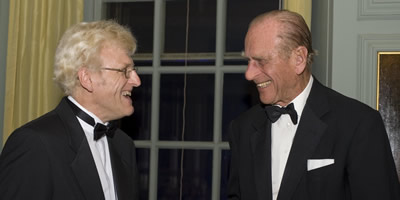Congratulations to John Lee
Congratulations on the Chancellor's Award for Teaching

HRH The Prince Philip Duke of Edinburgh presented the Chancellor's Award for Teaching to John Lee at a gala dinner in the Palace of Holyroodhouse.
John Lee has led development of a system known as "YouTute", supported by a grant from the Principal's e-Learning Fund (2007-8). In this system, video recordings of tutorial discussions are made available to students. The recordings of entire tutorials (from two cameras and a Smartboard) are streamed in an online environment in which students can extract "virtual clips" from the videos, annotate, tag and comment these, share them, and keep them for future reference. The videos are presented accompanied by the tutorial question sheets and, where appropriate, solutions, as well as the relevant lecture slides. This creates a new kind of learning resource, around which the students can develop a collaborative learning activity that will promote reflection, deepen understanding, and add significantly to the value of the original tutorial experience. Students can also observe different approaches to particular problems (and to teaching and learning) as revealed in different tutorial groups' discussions.
A robust prototype system is currently being trialled in Informatics, with great potential also for use in many other areas of the University. Over 50 tutorials were recorded in AY 2007-8 from Informatics 2A/B,which have been made available to all second year Informatics students since then (nearly 400 students). The system was especially appreciated by resit students revising during the summer, who used the system for over 50 hours, suggesting that it may be very helpful for the slower learners.
Collection of tutorials continues. The next step is to integrate recordings of lectures, which are increasingly captured in many subject areas, allowing these also to be re-used in a much more flexible and substantial way. The system is also the focus of research to assist students further by developing automated means of indexing and tagging the videos, exploiting methods developed in existing Informatics research on multi-party meetings.
YouTute exploits vicarious learning, which is learning from exposure to the learning experiences of others. John Lee has a long history of working to develop innovative ways of exploiting the concept of vicarious learning. He has been investigating this idea, with collaborators, in a series of projects since 1995, funded by EPSRC, ESRC, and the Teaching and Learning Research Programme — the recent Principal's e-Learning Fund grant has enabled a sharper focus on application to be added to this work. There is clear evidence that vicarious learning has substantial benefits for motivation and attitude as well as discussion skills and learning strategies. Research elsewhere also suggests that vicarious learners learn better if they collaborate with each other. It is to exploit these benefits, and also to evaluate subject-specific learning in much more detail, that practical application has become the focus, leading to the current YouTute deployment.
John has been keen to promote innovations in teaching for many years. 10 years ago, in what is now the School of Arts, Culture and Environment, he co-developed the highly successful MSc in Design and Digital Media. He introduced teaching of web design and technologies at a very early stage, and continues to teach these and direct this programme. In his seconded position in Informatics, he was the founding course organiser of the pioneering Informatics Entrepreneurship courses, one of which has also been adapted for use in Design and Digital Media.
Labels: award, chancellor, congratulations, learning, lee, vicarious, youtute

